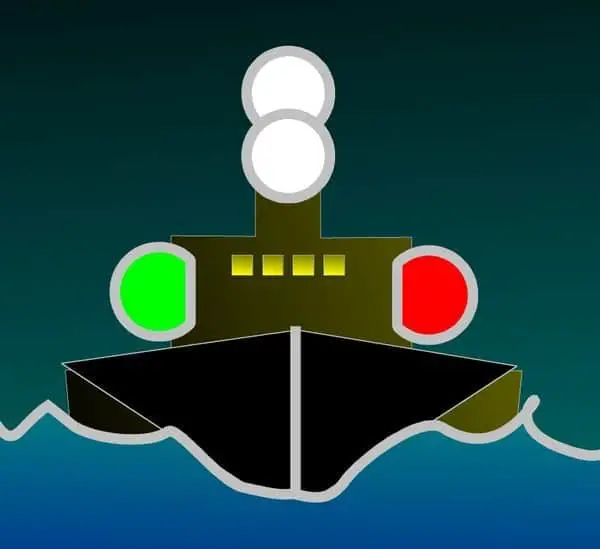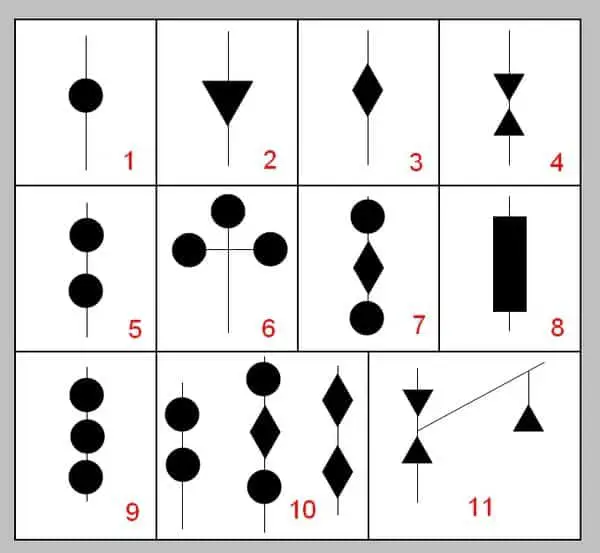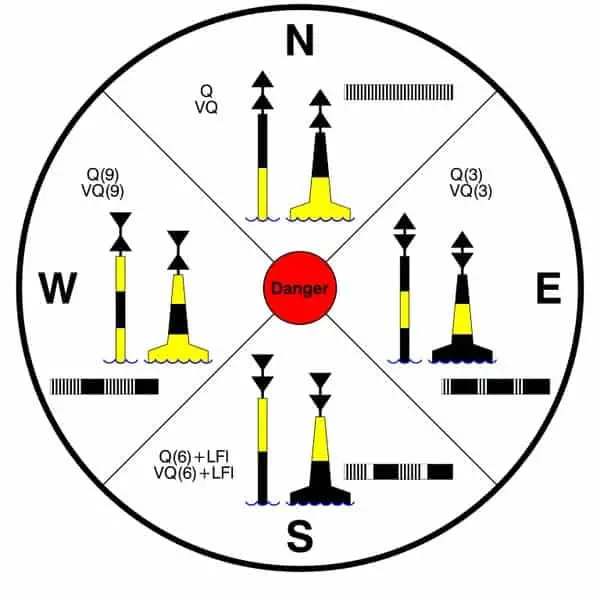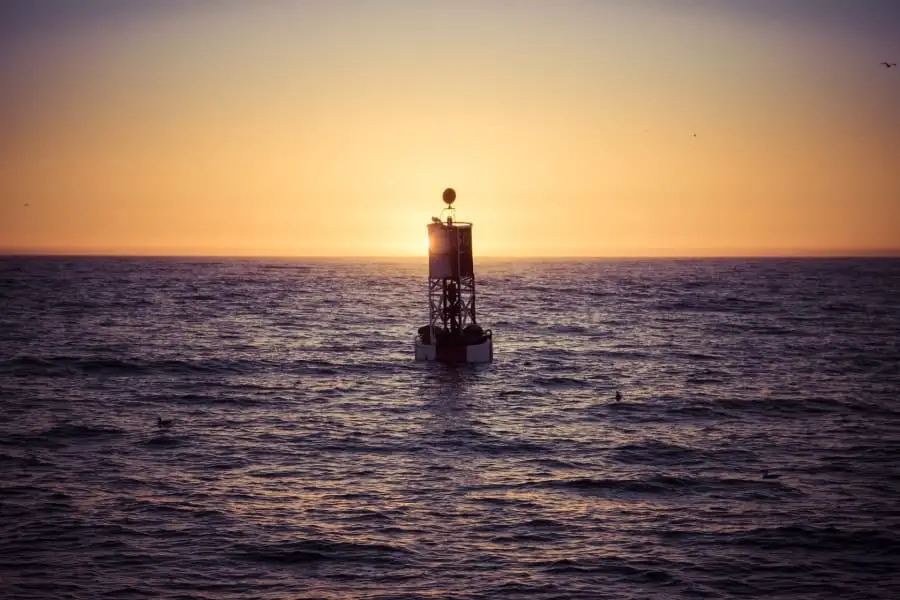You might be wondering what all those lights, shapes, and sounds that are either attached to a vessel or emanating from them.
While it might not be obvious what these mysterious modes of communication mean, they play a very important role in ensuring the safety and proper communication between vessels and non-vessels alike.
Sailing safety has a lot to do with proper preparedness, which means having the right gear, plan, experience, and mindset. However, sailing safety also requires knowledge in the various forms of communication between vessels and non-vessels. This is where lights, shapes, and sounds play a big role.
By using various lights, shapes, and sounds when out on the water, vessels and non-vessels are able to communicate whether there’s danger afoot, they need help, or simply telling you to get out of the way.
We’ll explore the most common and vitally important light, shape, and sound signals to make sure you’re able to pick up and recognize them when the time is right.
Vessel Lights

Whenever you see a vessel that has their lights on display, it’s most likely going to be during the evening when it matters most.
The combination of colors and how they’re oriented can mean a world of difference in terms of what they’re trying to communicate, so it’s important to keep an eye out.
The color of lights you’ll see when out on the water include white, red, green, and yellow. Again, you’ll see these on display at night when visual communication between vessels and non-vessels is crucial.
When you see lights on display, you’re essentially being told the vessel’s direction of movement, method of propulsion, and size.
Apart from the basic message of direction, propulsion method, and size, there are other light signals that are there to inform you of other situations. Some of those situations include when a vessel is
- Towing
- Not under command
- At anchor
- Aground
- Fishing
- Constrained by draft
- Unable to maneuver
The most important determination, when confronted with a vessel or non-vessel at night, is whether or not there’s a risk of collision.
Obviously, if there’s a risk of collision you need to attempt to communicate with the vessel immediately and to take proper action to avoid a collision. Ideally, you’ll be able to communicate with the other vessel so that you’re both in agreement about who does what to prevent a potential collision.
Basic Lights
As I mentioned previously, there are several basic colors that you’ll see on display from a vessel at night.
However, these lights can be displayed in different ways in terms of position on a vessel as well as how they’re displayed (e.g., blinking or static). Here are some basic definitions of lights that you should know.
Masthead Light
The masthead light is a static white light that sits partway up the main mast of a vessel and only displays to the front 225 degrees of the vessel.
This means that other vessels coming toward yours at an arc of 225 degrees will see an unbroken white light, which will inform them that you are possible head-on.
Sidelights
The sidelights are a pair of static lights that sit fore of the vessel at the bow with one being on the port side and the other on the starboard side.
The light on the port side is a static red light and the light on the starboard side is static green. The combination of both lights covers the same amount of arc as the masthead light, which is 225 degrees.
Sternlight
The sternlight is a static white light that sits as far back as possible aft the vessel at the stern and displays to the back 135 degrees of the vessel.
Other vessels who see this will know that they’re behind your vessel due to the light being lower than if they saw the masthead light and not being able to see the sidelights.
All-Round Light
The all-round light is a static white light that sits at the very top of a vessel’s mast and displays at a full 360-degree angle. You’ll see this light being displayed on a sailboat that’s either docked or at anchor.
Towing Light
The towing light is a static yellow light that sits at the same position as the sternlight and displays at an arc of 135 degrees aft the vessel. As the name suggests, this light indicates to other vessels that it’s currently towing an object.
Underway Vessels
When vessels are on the move and it’s dark out, there’s no doubt that being able to pick out fellow vessels is an important way to avoid any risk of collision.
In all likeliness, you’ll be able to pinpoint another vessel rather quickly at night be observing their lights and determine their position, direction of movement, and size.
Sailing Vessels
When spotting sailing vessels underway at night, you’ll be able to see at a bare minimum their sidelights and sternlight.
By observing which lights you can see and their orientation, you can quickly determine the position at which you’re viewing their vessel. However, depending on the size of the vessel, you’ll definitely see a different combination of lights.
If your vessel is less than 20 meters (65 feet) in length, then all you’ll need to display are the sidelights and sternlights when underway at night.
However, it’s also possible to display a similar set of lights in a different way indicating the same underway conditions, which is when you might see on the very top of the mast a 3-light combination — red, white, and green.
The 3-light combo displays at the same angles as the sidelights and sternlight. The only difference here is they’re situated at the top of the mast.
Sailing vessels underway that are larger than 20 meters will likely have a different set of lights on display, but the difference is huge.
With larger sailing vessels, you’ll still see the sidelights and sternlight with another pair of static lights near the top of the mast where the top light is red and the one below is green.
Power-Driven Vessels
Now, power-driven vessels are bit different when underway at night compared to sailing vessels. For one, a power-driven vessel can be as small or much larger than a sailing vessel, so the number of lights can vary quite a bit.
Also, a power-driven vessel is capable of much greater speeds than a sailing vessel, so ensuring other vessels are aware of their existence at night is very important.
Not unlike a sailing vessel, a power-driven vessel will also have a pair of sidelights and one sternlight. However, there’s an additional light that’s included in this combination and that being the white masthead light.
This 4-light combination will help other vessels like yours be aware that a 15 meter (50 feet) power-driven vessel is underway near them.
But what about the power-driven vessels that are well above the 15-meter size?
Well, the power-driven vessels that are much larger will have the same lights as the smaller power-driven vessel as well as a white static light at the bow that’s slightly lower in height than the masthead light.
This helps other vessels like yours get an idea of just how big this power-driven vessel really is.
Vessels At Anchor
Whenever you’re underway at night, there’s no doubt you want to be aware of other vessels underway to avoid a major collision.
But it’s also the case that you want to be able to spot those other vessels that are at anchor, especially if you’re moving around a marina or bay with other docked or anchored vessels.
Sailing vessels at anchor are very easy to pick out at night since all they need to have on display is their all-round light.
Remember that the all-round light is a static white light that provides a 360-degree view at the very top of a sailing vessels mast, so it’ll be quite difficult to miss. As a matter of fact, a power-driven vessel at anchor also has the same all-round light on display as long as it’s 50 meters (65 feet) or less in size.
For sailing and power-driven vessels that are greater than 50 meters in size, they have to put on display another all-round light.
However, this extra all-round light is placed near the stern of the vessel and is lower in height compared to the all-round light on the mast. This combination of all-round lights should tell you right away that you’re looking at a much larger vessel at anchor.
If you just so happen to see a vessel that’s greater than 100 meters (328 feet) in size and it’s also at anchor, you best believe you’ll see it lit up like a Christmas tree. When it comes to this size of a vessel, they’re required to put as many lights on display as possible.
Day Shapes

Most of what we’ve covered up to this point has been under the conditions of being underway or at anchor during the evening.
However, arguably more vessels will be out during the day than at night, so it’s important to be aware of other forms of visual communication such as day shapes.
During the day there’s little need for lights to communicate visually to other vessels, which is why we use shapes instead. There are a number of different shapes that take the form of circles, squares, triangles, and more that communicate different messages.
While there are a lot of different day shapes to consider, I want to cover the most common you’ll likely see while out on the water.
Anchored
Being able to pinpoint a vessel, whether sailing or power-driven, that’s anchored during the day is rather straight forward as you should see a large black sphere hanging between the tip of the vessel’s mast to the fore of the vessel.
This single black sphere should be the size of a basketball and will be attached in the middle of a line.
Motoring and Sailing
If you’re out sailing and have your engine running to help boost your speed, you’ll need to ensure that you have a black, upside-down triangle attached to the middle of your forestay.
Just like the black sphere used to illustrate that your vessel is anchored, your sailboat should have the upside triangle in the same location. It’s important to note that this is only required for vessels that are 12 meters (39 feet) or greater in size.
Diving Operations
If you like to go freediving, scuba diving, or snorkeling, you’ll want to be sure to use the proper diving day shape.
Whether you’re on a small or medium sized vessel, make sure you put up the correct flag at the top of the mast. The most commonly used flag is blue and white while another flag is red with a white slash from one corner to another.
Aground
One of the worst situations you can find yourself or anyone else in while out sailing is ending up aground.
If this situation ever occurs, there should be three black spheres, just like the one you would use when anchored out, attached to the top of the mast in a vertical column. It’s important to note that this is only required for vessels that are 12 meters (39 feet) or greater in size.
Not Under Command
There will be times when vessels out on the water won’t be under command, which means you should be aware of this so you can make sure you can avoid them on your course.
Just like a vessel that’s run aground, you should see black spheres lined up vertically at the top of the mast, but instead of three spheres there should only be two. Again, this is only required for vessels that are 12 meters (39 feet) or greater in size.
Restricted Maneuverability
Some vessels can find themselves in situations that simply restrict their ability to maneuver, so being able to put that inability on full display to the rest of the vessels out on the water is rather important.
By putting a black, diamond-shaped object in between two black spheres in a vertical column at the top of the mast, this message is illustrated successfully. Similar to other day shapes, you’ll only find this on vessels that are 12 meters (or 39 feet) or greater in size.
Fishing and Trawling
Fishing is one of the oldest industries in the world and there’s no doubt that you’ll eventually find a vessel fishing and towing along a net.
Whenever a vessel is trawling, you should find two triangle shapes pointing at each other in a vertical column hoisted as high as possible.
There are also a few strange looking flags you’ll find being hoisted in the same location whenever a fishing vessel is either shooting nets, hauling nets, or their nets are caught on the seabed.
Buoys and Marks

Being able to safely navigate around other vessels out on the water is, of course, extremely important, but it’s also important to be observant of non-vessel objects that could get in your sailboat’s way.
Circumventing spots that are potentially dangerous comes first by being able to recognize the various buoys and marks on the water.
There are internationally agreed sets of buoys and marks that ensure safety for traveling vessels all over the world. Thanks to the International Association of Lighthouse Authorities (IALA), we have two major systems to abide by located in two different worldwide regions.
Fortunately, these two regions — Region A and B — have very few impactful differences. Region A (IALA A) covers all of Europe and pretty much the rest of the world while Region B (IALA B) covers the USA, Japan, The Philippines, and Korea.
Major Difference Between IALA A and IALA B
The major difference between the two regions is regarding the buoys which define which side of a channel the vessels should be traveling on.
For example, IALA B has red lights, marks, and/or buoys on the starboard (right) side of a channel when entering a place such as a harbor while under IALA A standards the red lights, marks, and/or buoys are on the port (left) side of a channel when entering.
These are known as lateral or channel marks and define the limits of the water that navigable across a channel.
Port and Starboard Marks
When it comes to buoys and marks that specify the port or starboard side of an object, the port side of an object is red and the starboard side of an object is green.
This is the same for when you’re sailing your boat when it comes to the foremost red and green lights on your vessel.
In regards to specific shapes of port and starboard marks, under the IALA B standards, port marks take the shape of a cone while the starboard marks take the shape of a can.
Safe Water Marks
A Safe Water Mark, also known as a Fairway buoy, is a red and white vertically striped object usually taking the shape of a sphere, pillar, or spar with a red ball on the top for the non-sphere shapes.
This mark usually indicates that you’re entering open and deep waters which should continue as you sail onwards.
Isolated Danger Marks
Having a mark named Isolated Danger Mark isn’t too comforting when you first read it, but it’s one of the most useful marks you’ll find. As the name implies, this mark indicates a location of potential hazard that should be avoided at all costs.
The Isolated Danger Mark should always be red and black horizontal bands with two black balls at the top. It should also have a flashing white light that comes in groups of two flashes.
Special Marks
A Special Mark can carry a number of different meanings, but it’s always displayed in the same way. Special Marks should be completely yellow and have an ‘X’ on the top of it.
A yellow flashing light is also found on the top of the Special Mark and can be seen quite distinctly at night. The reason you could find yourself near a Special Mark is due to it indicating
- Water skiing areas
- Anchorage areas
- Mooring areas
- Waiting areas
- Marine farms
- Oil wells
- Dead ends
- Pipelines
- Historic wrecks
- Protected areas
- Sewerage pipes
- Submarine cables
Cardinal Buoyage System

Another useful set of buoys is based on the Cardinal Buoyage System, which was designed to indicate the safe passage around a potentially hazardous area.
These Cardinal Marks are signaling to vessels that there’s an area that’s shallow, contains sunken objects, reefs, rocks, or something else.
By observing the Cardinal Marks, you’ll be able to tell where not to go based on their explicit placement. For example, if you see a North Cardinal Mark, your vessel can safely pass the hazard by traveling North of that marker.
The same goes for South, East, and West Cardinal Marks. Cardinal Marks are always black and yellow horizontally striped pillars.
The North Cardinal Mark is black on the top, yellow on the bottom, has two vertical triangles pointing up, and has a continuously flashing white light on the top.
The South Cardinal Mark is yellow on the top, black on the bottom, has two vertical triangles pointing down, and has a flashing white light on the top that flashes in groups of six followed by one long flash.
The East Cardinal Mark is black with a yellow stripe in the middle, has two vertical triangles pointing outward, and has a flashing white light on the top that flashes in groups of three.
The West Cardinal Mark is yellow with a black stripe in the middle, has two vertical triangles pointing inward, and has a flashing white light on the top that flashes in groups of nine.
Sound Signals
There may be times when you’re out sailing and the visibility is just too poor to be able to point out any buoys, flags, or shapes of any kind. Thankfully, we have light signals that can help us out when it comes to navigation around other vessels and potentially hazardous areas.
However, there may be times when we need to communicate more direct messages much more quickly. If VHF is not an option under these conditions, the use of sound signals is your go-to solution.
“You Are Running into Danger”
There are plenty of useful sound signals to be able to send out as well as recognize when the moment’s right, but there’s one that everyone should be aware of.
When someone yells “heads up!”, it’s likely you’re going to cover your head as soon as possible. When out on the water, the “heads up” can come in the form of two distinct sounds.
When someone is attempting to warn you that “you are running into danger” or you need to inform another vessel of this, you’ll need to know the Morse code word for ‘U’.
The word ‘U’ is presented as a one-second horn blast followed by a 4-6 second horn blast. You can think of this as a short blast followed by a long blast.
In all likeliness, you’ll be the one hearing this sound signal as opposed to you sending it out. Most of the time when this sound signal is used, it’s coming from much larger vessels such as oil rigs, cruise ships, and other vessels of similar size.
Poor Visibility Sound Signals
There are a few sound signals that you should keep in mind when visibility becomes poor while out on the water. Some of the most important include:
- Power underway, making way: one 4-6 second blast and a 2-minute wait.
- Power underway, not making way: two 4-6 second blasts and a 2-minute wait.
- Vessel sailing, fishing, not under command, towing, maneuverability restricted: one 4-6 second blast, two 1 second blasts, and a 2-minute wait.
- Last manned vessel of tow: one 4-6 second blast, three 1 second blasts, and a 2-minute wait.
- Warning from vessel at anchor: one 1 second blast, one 4-6 second blast, and one 1 second blast.
- Plot vessel on duty: four 1 second blasts.
- Vessel at anchor: 5 seconds of rapid bell ringing and a 1-minute wait.
- Vessel aground: 3 short bell rings, 5 seconds of rapid bell ringing, and 3 short bell rings.
Maneuvering and Warning Sound Signals
If you ever find yourself communicating with another vessel using sound signals, you’ll definitely need to confirm with one another who’s going to do what so as to avoid the risk of a collision.
Here are some of the most important sound signals you can use to communicate with other vessels.
- I’m altering course to starboard: one 1 second blast.
- I’m altering course to port: two 1 second blasts.
- I’m operating stern propulsion: three 1 second blasts.
- I don’t understand your intentions! I doubt you’re taking sufficient action to avoid collision: five or more 1-second blasts.
- I intend to overtake on your starboard side: two 4-6 second blasts and one 1 second blast.
- I intend to overtake on your port side: two 4-6 second blasts and two 1 second blasts.
- Agreement by overtaken vessel: one 4-6 second blast, one 1 second blast, one 4-6 second blast, and one 1 second blast.
- Approaching blind bend in channel: one 4-6 second blast.
- Reply from vessel on other side of bend: one 4-6 second blast.


